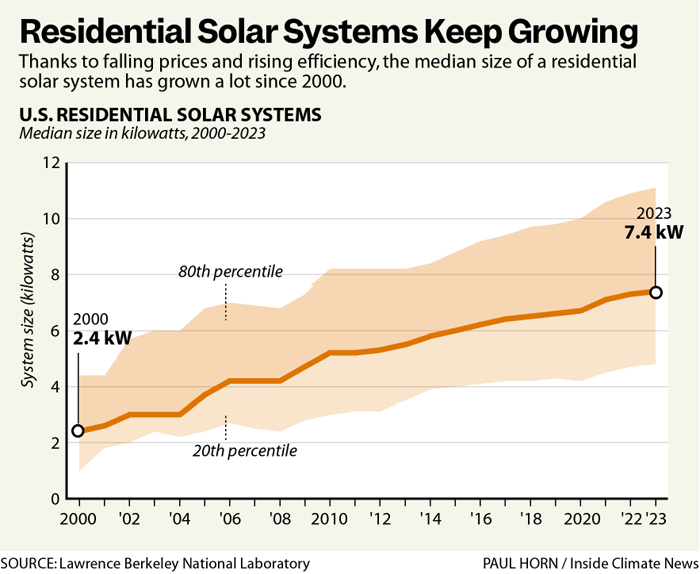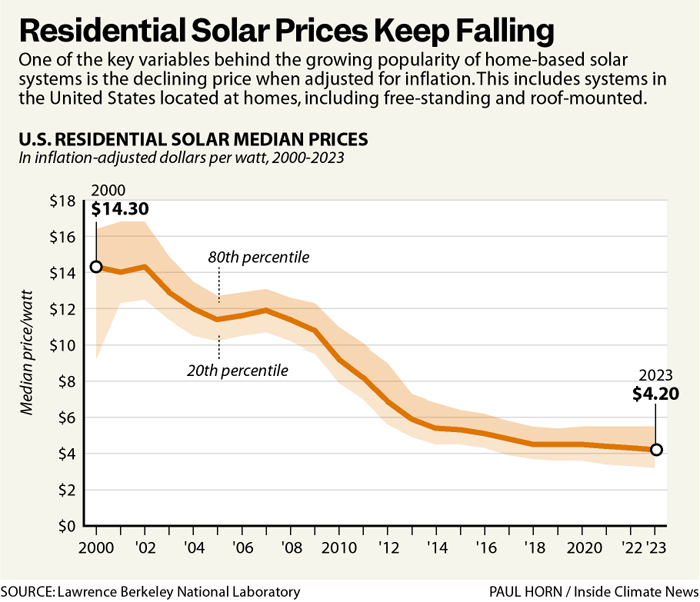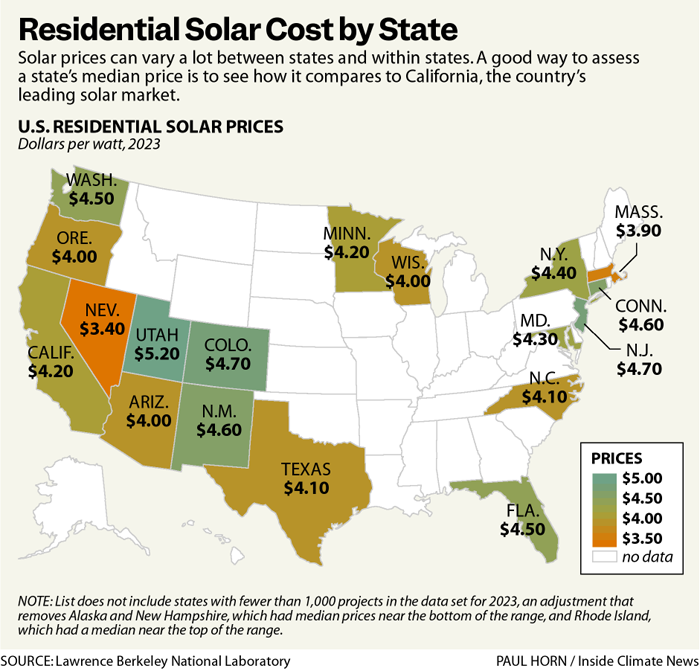Bigger and Less Expensive: A Snapshot of U.S. Rooftop Solar Power and How It’s Changed
Your roof isn’t getting any bigger, but the amount of electricity that can be produced by solar panels up there has grown by a lot compared to a generation ago.
New figures from Lawrence Berkeley National Laboratory show how much: The median size of a residential solar system grew from 2.4 kilowatts in 2000 to 7.4 kilowatts in 2023.
Size, in this case, refers to the generating capacity of a solar system, not its surface area. The tripling of median size, despite the surface area of a typical roof not changing much, is a boon for consumers and the grid.
Lawrence Berkeley Lab published a trove of data last week as part of the annual “Tracking the Sun” report on customer-owned solar. The report, which looks at data from 2023, shows a continuation of major trends like the growth of panel efficiency, a drop in prices and an increase in solar systems that are paired with battery storage.
Prices and system size had only tiny changes from 2022 to 2023. Median size increased by 0.1 kilowatts. Median price was $4.20 per watt, down from $4.30 per watt, adjusted for inflation.

The report is based on a sample of 3.7 million customer-owned solar systems, about three-quarters of the total installed in the United States.
To get a better sense of progress, it helps to take a longer view. I asked Galen Barbose, a staff scientist at Lawrence Berkeley Lab and co-author of the report, which long-term trends he finds the most striking. He pointed to the growth in system size.
“Customers are able to meet more of their load and save more on their bills,” he said.
The increase in system size is closely related to improvements in solar panel efficiency, a measure of how much of the solar radiation shining on a panel’s surface is converted to electricity.
Explore the latest news about what’s at stake for the climate during this election season.
Last year, more than 90 percent of solar panels had efficiency of at least 20 percent, which is remarkable considering that no residential panels had that level of efficiency as recently as 2011, according to the report. The rapid shift follows technological change, such as the development of “TOPCon” solar panels, which have a mix of materials that achieve greater efficiency with minimal increase in costs.
Even as residential solar prices continue to decline, the United States has high prices relative to peers. Prices in Australia, for example, have fallen to less than $1 per watt. Energy analysts have asked why there is such a large gap between the United States and Australia.

“It’s undeniable that residential [solar] prices in most of the other markets are way below the U.S., and that has to do with soft costs,” Barbose said.
By “soft costs,” he means the expenses that aren’t for hard goods like solar panels and inverters. This includes labor, financing and permits, among others, and it’s included in calculations of the cost per watt.
Driving down soft costs is complicated and difficult, and it’s sometimes in conflict with the idea that solar industry jobs should have high pay and good benefits.
The report helps me to appreciate the challenge of driving down costs because of the way it shows the range of prices. Nationally, the middle 60 percent of projects—from the 20th percentile to the 80 percentile—have prices that range from $3.20 to $5.50 per watt, which is a lot of variation.
Prices vary significantly by state. California, the country’s leader, has a median price that’s the same as the national median, $4.20, while Nevada is on the low end with $3.40, and Utah is on the high end with $5.20.
There are many possible explanations for the differences by state, including the competitive balance of companies doing the installs, the typical sizes of projects being done and local regulations that affect costs.

Rooftop solar installation is mainly done by small- and medium-size companies, which leads to a wide variety of approaches and cost variation. The country’s top 10 installers represented a combined 36.7 percent of the market, the report said.
Here are a few additional findings:
- More buyers are getting rooftop solar in tandem with battery storage, representing 9.4 percent of residential systems last year, up from 8.8 percent in the prior year, and up from near-zero as recently as 2015.
- Solar leasing gained in popularity last year, with 27.4 percent of the market, up from 25 percent in the prior year. This follows about a decade of steady decreases as fewer companies have emphasized selling leases and more consumers obtained loans to buy solar systems rather than signing leases. The shift may be because leased systems are eligible for aid under the Inflation Reduction Act.
- Solar panels usually get the most sun if they face south, and 56 percent of the systems installed last year are south-facing, a figure that is about the same as prior years. Next are west-facing systems with 23 percent, and most of the rest are east-facing.
Other stories about the energy transition to take note of this week:
States Are Falling Behind in Using IRA Funding to Advance Climate Action: A report from RMI shows that the federal government has distributed $66 billion from the Inflation Reduction Act, which is about 6 percent of what’s needed for the country to meet its climate commitments. There is no upper limit on what can be spent under the law, so the level of spending is closely tied to investment decisions by states and developers, as Syris Valentine reports for Grist. The RMI report looks at how well each state has been able to obtain federal incentives.
Federal Government Proposes Opening 31 Million Acres of Public Land for Solar Development: The U.S. Bureau of Land Management has released an update to its Western Solar Plan that increases the amount of land available for solar development from 22 million acres to 31 million acres, as Emma Penrod reports for Utility Dive. The change, which was in response to comments from solar developers, is part of an effort by the Biden administration to speed up the permitting process for solar farms while also steering development away from areas with potential conflicts.
Biden Administration Weighs Price Support for U.S. Critical Minerals Amid Chinese Pressure: The Biden administration is considering using federal money to support U.S. critical mineral projects that are facing competition with cheaper Chinese materials, as James Bikales reports for Politico. The idea, which has not been publicly announced, is that the government would set a price floor for certain resources and agree to pay the difference when market prices fall below that level. The administration is mulling this action because of delays and cancellations of several mineral processing projects that were going to increase the supply of materials needed for batteries and other products necessary for a shift away from fossil fuels.
A Plant-Based Material Could Be Used to Make Recyclable Wind Turbine Blades: Researchers at the National Renewable Energy Laboratory say they have developed a wind turbine blade made from plant material that can be recycled, as Minho Kim reports for The New York Times. The substance is made from inedible sugar extracted from wood, plant remains, used cooking oil and agricultural waste.
What’s Stalling Electric Vehicle Adoption in Wyoming? Politics and a lack of charging infrastructure are among the obstacles to EV adoption in Wyoming, as Najifa Farhat reports for ICN. Wyoming has the second-lowest number of EVs in the country after North Dakota and many of its elected officials oppose policies that would encourage use of the vehicles.
Inside Clean Energy is ICN’s weekly bulletin of news and analysis about the energy transition. Send news tips and questions to [email protected].
About This Story
Perhaps you noticed: This story, like all the news we publish, is free to read. That’s because Inside Climate News is a 501c3 nonprofit organization. We do not charge a subscription fee, lock our news behind a paywall, or clutter our website with ads. We make our news on climate and the environment freely available to you and anyone who wants it.
That’s not all. We also share our news for free with scores of other media organizations around the country. Many of them can’t afford to do environmental journalism of their own. We’ve built bureaus from coast to coast to report local stories, collaborate with local newsrooms and co-publish articles so that this vital work is shared as widely as possible.
Two of us launched ICN in 2007. Six years later we earned a Pulitzer Prize for National Reporting, and now we run the oldest and largest dedicated climate newsroom in the nation. We tell the story in all its complexity. We hold polluters accountable. We expose environmental injustice. We debunk misinformation. We scrutinize solutions and inspire action.
Donations from readers like you fund every aspect of what we do. If you don’t already, will you support our ongoing work, our reporting on the biggest crisis facing our planet, and help us reach even more readers in more places?
Please take a moment to make a tax-deductible donation. Every one of them makes a difference.
Thank you,
David Sassoon
Founder and Publisher
Vernon Loeb
Executive Editor
Share this article
Disclaimer: The copyright of this article belongs to the original author. Reposting this article is solely for the purpose of information dissemination and does not constitute any investment advice. If there is any infringement, please contact us immediately. We will make corrections or deletions as necessary. Thank you.
Title:Bigger and Less Expensive: A Snapshot of U.S. Rooftop Solar Power and How It’s Changed
Url:https://www.investsfocus.com








